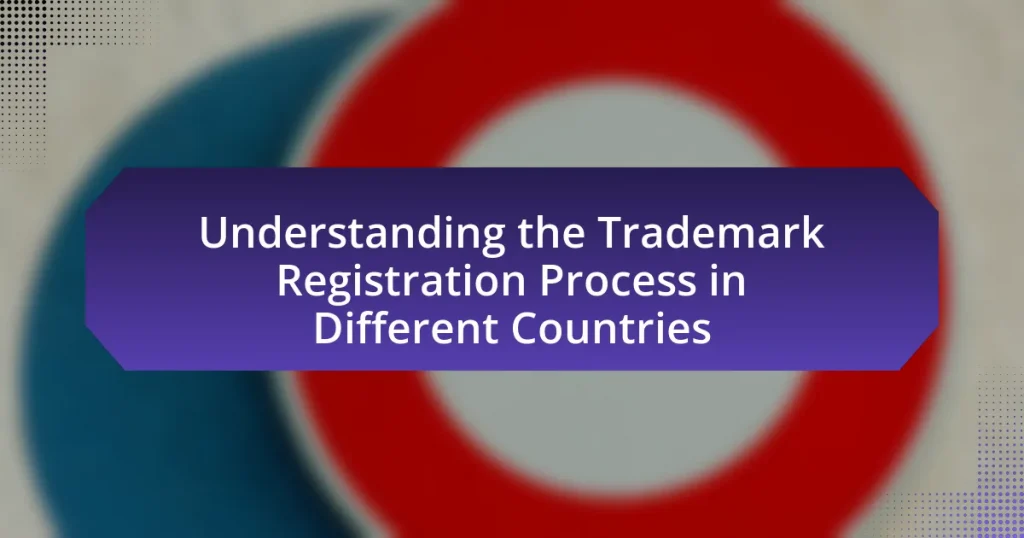Trademarks, service marks, and trade names are essential forms of intellectual property that serve to identify and distinguish goods and services in the marketplace. Trademarks protect symbols, words, or phrases associated with products, while service marks fulfill a similar role for services. Trade names represent the official name under which a business operates and can include both trademarks and service marks. Understanding the distinctions between these identifiers is crucial for legal protection, brand identity, and effective business strategies, as each serves a unique purpose in commerce and intellectual property law. The article explores the definitions, legal protections, and implications of each type, as well as the risks businesses face if they confuse these terms.

What are Trademarks, Service Marks, and Trade Names?
Trademarks, service marks, and trade names are distinct forms of intellectual property that identify and distinguish goods and services. A trademark specifically protects symbols, words, or phrases used to identify products, ensuring that consumers can recognize the source of those goods. Service marks serve a similar purpose but are used to identify and distinguish services rather than products. Trade names, on the other hand, refer to the official name under which a business operates and can encompass both trademarks and service marks. For example, the name “Coca-Cola” is a trademark for beverages, while “Coca-Cola Company” is a trade name representing the business entity. These distinctions are crucial for legal protection and brand identity in commerce.
How do Trademarks differ from Service Marks?
Trademarks and service marks differ primarily in the type of goods or services they represent. A trademark identifies and distinguishes the source of goods, while a service mark identifies and distinguishes the source of services. For example, the Nike swoosh is a trademark for athletic footwear, whereas the slogan “Just Do It” serves as a service mark for Nike’s promotional services. Both trademarks and service marks are protected under intellectual property law, but their application is specific to the nature of the offerings they represent.
What legal protections do Trademarks provide?
Trademarks provide legal protections that prevent unauthorized use of distinctive signs, symbols, or names that identify goods or services. These protections allow trademark owners to enforce their rights against infringement, ensuring that consumers can distinguish between different products and services in the marketplace. Trademark registration grants exclusive rights to the owner, enabling them to take legal action against parties that use similar marks in a way that could cause confusion among consumers. Additionally, trademarks can be renewed indefinitely as long as they are in use, providing ongoing protection.
What legal protections do Service Marks provide?
Service marks provide legal protections similar to trademarks, specifically for services rather than goods. These protections prevent others from using a mark that is confusingly similar to the service mark in a way that could mislead consumers about the source of the services. Under the Lanham Act, service marks can be registered with the United States Patent and Trademark Office (USPTO), granting the owner exclusive rights to use the mark in commerce. This registration also provides a legal presumption of ownership and the right to sue for infringement, reinforcing the mark’s protection against unauthorized use.
What role do Trade Names play in business identification?
Trade names serve as a primary identifier for businesses, distinguishing them from competitors in the marketplace. They are often the name under which a business operates and is recognized by consumers, playing a crucial role in branding and marketing strategies. For instance, a trade name can enhance customer recognition and loyalty, as seen with companies like Coca-Cola and Apple, which have built strong brand identities around their trade names. Additionally, trade names can be registered to provide legal protection against unauthorized use, further solidifying their importance in business identification.
How are Trade Names different from Trademarks?
Trade names and trademarks serve different purposes in business identification. A trade name is the official name under which a business operates and is used for commercial purposes, while a trademark is a symbol, word, or phrase legally registered or established by use as representing a company or product. Trade names identify the business itself, whereas trademarks protect the brand identity associated with specific goods or services. For example, “Coca-Cola” is a trade name for the company, while the logo and the name itself are trademarks that distinguish its beverages from others in the market.
What are the legal implications of using a Trade Name?
Using a trade name can lead to legal implications such as potential trademark infringement, liability for false advertising, and issues with business registration. Trade names, while not registered trademarks, can still be protected under common law if they are distinctive and used in commerce. If a trade name is similar to an existing trademark, the owner of that trademark may pursue legal action for infringement, which can result in costly litigation and the requirement to cease using the trade name. Additionally, businesses must ensure that their trade name does not mislead consumers, as this could lead to claims of false advertising. Furthermore, proper registration of a trade name with state authorities is necessary to avoid legal complications and ensure compliance with local business laws.

Why is it important to understand the differences?
Understanding the differences between trademarks, service marks, and trade names is crucial for effective brand protection and legal compliance. Each term serves a distinct purpose in intellectual property law; trademarks protect goods, service marks protect services, and trade names identify businesses. Misunderstanding these differences can lead to inadequate protection of brand assets, potential legal disputes, and loss of consumer trust. For instance, a company that fails to register its trademark may lose exclusive rights to its brand, as seen in cases where businesses have faced infringement issues due to lack of clarity in their branding strategy.
How can businesses benefit from distinguishing between these terms?
Businesses can benefit from distinguishing between trademarks, service marks, and trade names by ensuring legal protection and enhancing brand identity. By clearly defining these terms, companies can avoid potential legal disputes and infringement issues, as trademarks protect goods, service marks protect services, and trade names identify the business itself. For instance, a study by the International Trademark Association highlights that businesses with registered trademarks experience 20% higher revenue growth compared to those without, demonstrating the financial advantage of proper brand differentiation. This understanding allows businesses to strategically position their offerings in the market, fostering customer loyalty and trust.
What risks do businesses face if they confuse these terms?
Businesses face significant legal and financial risks if they confuse trademarks, service marks, and trade names. Misunderstanding these terms can lead to trademark infringement, resulting in costly lawsuits and potential damages. For instance, a company may inadvertently use a service mark that is already registered, exposing itself to legal action from the rightful owner, which can lead to financial penalties and loss of brand reputation. Additionally, confusion can result in ineffective brand protection strategies, making it difficult for businesses to defend their intellectual property rights. According to the United States Patent and Trademark Office, proper identification and use of these terms are crucial for maintaining brand integrity and avoiding legal disputes.
How can proper usage enhance brand protection?
Proper usage enhances brand protection by ensuring that trademarks, service marks, and trade names are consistently applied in accordance with legal standards, which helps maintain their distinctiveness and prevents dilution. When brands are used correctly, they reinforce consumer recognition and trust, thereby reducing the risk of infringement and unauthorized use. For instance, a study by the International Trademark Association indicates that consistent trademark usage can lead to a 20% increase in brand loyalty among consumers, demonstrating the importance of proper application in safeguarding brand identity.
What are common misconceptions about Trademarks, Service Marks, and Trade Names?
Common misconceptions about trademarks, service marks, and trade names include the belief that they are interchangeable, that registration is mandatory for protection, and that they last indefinitely without renewal. Trademarks protect goods, service marks protect services, and trade names identify businesses, each serving distinct purposes. While registration enhances legal protection, common law rights can exist without it. Additionally, trademarks and service marks require periodic renewal to maintain their status, contrary to the assumption that they last forever. These distinctions are crucial for businesses to understand to effectively protect their intellectual property.
Why do some people think all business identifiers are the same?
Some people think all business identifiers are the same because they often conflate trademarks, service marks, and trade names due to a lack of understanding of their distinct legal definitions and functions. Trademarks protect goods, service marks protect services, and trade names identify businesses, yet many individuals do not recognize these differences, leading to the misconception that they serve the same purpose. This confusion is compounded by the fact that all three identifiers are used in branding and marketing, which can create an impression of interchangeability despite their unique legal implications.
How can misinformation affect business decisions?
Misinformation can significantly distort business decisions by leading to incorrect assessments of market conditions, consumer behavior, and competitive dynamics. For instance, if a company believes false information about a competitor’s financial health, it may make misguided strategic moves, such as underestimating competition or overinvesting in a failing product line. A study by the Harvard Business Review found that 70% of executives reported that misinformation had negatively impacted their decision-making processes, illustrating the tangible consequences of relying on inaccurate data.

What are the practical steps for businesses regarding these identifiers?
Businesses should register trademarks, service marks, and trade names to protect their brand identity and prevent unauthorized use. The first practical step is to conduct a thorough search to ensure that the desired identifier is not already in use or registered by another entity. Following this, businesses should file an application with the appropriate governmental body, such as the United States Patent and Trademark Office (USPTO), to secure legal protection. Additionally, businesses should monitor the market for potential infringements and enforce their rights when necessary. According to the USPTO, registered trademarks can last indefinitely as long as they are in use and renewed appropriately, providing long-term brand security.
How can a business effectively register a Trademark or Service Mark?
A business can effectively register a Trademark or Service Mark by following a systematic process that includes conducting a thorough search, completing the application, and submitting it to the appropriate government office. First, the business should perform a comprehensive trademark search to ensure that the desired mark is not already in use or registered, which can be done through databases like the United States Patent and Trademark Office (USPTO) Trademark Electronic Search System (TESS). Next, the business must fill out the application form accurately, providing details such as the mark, the goods or services it will represent, and the basis for filing. Finally, the completed application should be submitted to the USPTO along with the required fees. According to the USPTO, proper registration can provide legal protection and exclusive rights to use the mark in commerce, reinforcing the importance of following these steps meticulously.
What is the process for Trademark registration?
The process for trademark registration involves several key steps. First, an applicant must conduct a trademark search to ensure that the desired mark is not already in use or registered by another entity. Next, the applicant files a trademark application with the relevant government authority, such as the United States Patent and Trademark Office (USPTO) in the United States. This application includes details about the trademark, the goods or services it will represent, and the basis for filing.
After submission, the application undergoes examination by a trademark examiner, who assesses its compliance with legal requirements. If the application is approved, it is published in an official gazette, allowing third parties to oppose the registration within a specified period. If no opposition is filed, or if any opposition is resolved in favor of the applicant, the trademark is registered, and a certificate of registration is issued. This process typically takes several months to over a year, depending on various factors, including the complexity of the application and any potential disputes.
What is the process for Service Mark registration?
The process for Service Mark registration involves several key steps. First, an applicant must conduct a trademark search to ensure that the desired service mark is not already in use or registered by another entity. Next, the applicant files an application with the United States Patent and Trademark Office (USPTO), providing details such as the mark, the services it represents, and the basis for filing (either use in commerce or intent to use). After submission, the USPTO examines the application for compliance with legal requirements and potential conflicts. If approved, the mark is published in the Official Gazette, allowing third parties to oppose the registration. If no opposition arises, or if any opposition is resolved, the service mark is registered, granting the owner exclusive rights to use the mark in connection with the specified services. This process is supported by the Lanham Act, which governs trademark registration in the United States.
What best practices should businesses follow when choosing a Trade Name?
Businesses should choose a trade name that is distinctive, memorable, and not easily confused with existing names. A distinctive name enhances brand recognition and helps in trademark registration, as unique names are more likely to be granted protection under trademark law. For instance, according to the United States Patent and Trademark Office, names that are arbitrary or fanciful are the strongest candidates for trademark protection. Additionally, businesses should conduct thorough searches to ensure the chosen name is not already in use or trademarked, which can prevent legal disputes and brand confusion. This practice is supported by the fact that over 50% of trademark disputes arise from similar names in the same industry. Lastly, businesses should consider the cultural implications and potential translations of the name in different markets to avoid negative connotations, as evidenced by companies like Coca-Cola, which successfully navigated this challenge in various international markets.
How can businesses ensure their Trade Name is unique?
Businesses can ensure their Trade Name is unique by conducting thorough searches in trademark databases, state business registries, and online platforms. This process involves checking the United States Patent and Trademark Office (USPTO) database, as well as local and state business name registries, to identify any existing names that are similar or identical. Additionally, businesses should perform internet searches and social media checks to confirm that no other entities are using the same or a confusingly similar name. This diligence helps prevent potential legal disputes and ensures brand differentiation in the marketplace.
What resources are available for checking Trade Name availability?
To check Trade Name availability, individuals can utilize state business registries, which are typically maintained by the Secretary of State’s office in each state. These registries provide searchable databases where users can verify if a specific trade name is already in use or registered. Additionally, the United States Patent and Trademark Office (USPTO) offers a Trademark Electronic Search System (TESS) that allows users to search for federally registered trademarks, which can include trade names. These resources are essential for ensuring that a desired trade name does not infringe on existing registrations, thereby preventing potential legal issues.



